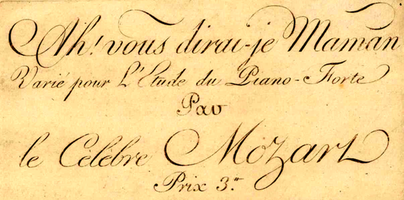
This is a continuation of my series of notes from when my students and I took the online Write Like Mozart class last year.
Between the 3rd and 4th week of the course, I had an epiphany on the merits of what Professor Edwards calls Texture Reduction and the application of patterns. Here I speak of how Professor Edwards’ approach to teaching music theory as a generative process differs from what I experienced in school and the wonders of applying patterns to textural reductions. A few quick hints are offered at the end of the post.
This is the fourth post in this series.
This course has been a FABULOUS study of theory & composition. Nothing new is being presented to me, but how it is presented is new to both Maria and me. It has opened my eyes to a completely new way of thinking about composition and improvisation.
What is new is the generative aspect of using music theory to generate composition. Music Theory is typically taught as a tool for the analysis of music. But as a composer, I use my music theory knowledge constantly. I know what harmonies tend to work, and I use this knowledge to help guide me through stages where I’m “fixing” my music when it doesn’t sound right. I also use it to guide my improvisations. I’ve also used the same voice leading guidelines he offers in my compositions for many years.
One thing different from anything the way Maria and I were taught is how Professor Edwards applies patterns to the core harmonic texture of the keyboard (and later other instrument) voicing. This was introduced in Week 2 and is expanded upon in Weeks 3 & 4. During week 3, I made the following connection:
I can analyze a piece down to its textural reduction (as he introduced in the end of week 2) and apply new patterns to that reduction (as in Weeks 2, 3, & 4) to end up with a NEW piece that essentially is a variation of the OLD piece.
A lightbulb went off in my mind. This must be how Mozart thought when he would improvise variations on a piece. Consider Mozart’s famous set of 12 piano variations on Ah vous dirai-je, Maman – aka Twinkle Twinkle Little Star. An analysis of the piece shows similar harmonic and voice leading structure between the variations with a different “patterns” applied over these structures. I am convinced that this is how Mozart thought when he composed and improvised. (Not to belittle at all the genius that went into it, too!)
I’m also betting that this way of thinking is key to how Mozart could hear a piece and reconstruct it from memory: Mozart heard the textural reduction with the patterns added on top of that. All piano students should be taught this type of analytical approach to aid in memorization: Do the Textural Reduction, analyze the patterns placed on top of that, et voila, you have a strong mental foundation for how the piece is constructed.
At this point of the course, I had a lesson with a composition student also taking the Write Like Mozart class. He was working on a theme and variations. In that lesson, we took his theme, applied a textural reduction to it, and then started experimenting with applying different patterns to it. We included patterns with suspensions (not unlike the class’ Circle of Fifths Elaboration 2 in Week 3). The results were amazing, and amazing easy to generate. Why wasn’t I taught theme and variations this way 30 years ago?
So, by week 4, I have come up with at least the two major concepts I want all of my students to take from this course:
- Understand Keyboard Voicing & Textural Reduction
- Understand how Patterns Can be applied to this to create real pieces of music.
And these are the details that help make the big ideas work:
- Know the Voice Leading Rules
- Know the basic harmonic progressions (I IV V and variations, Sequential Progressions)
- Know the types of harmonic expansions covered in Weeks 4-6 (Diatonic Substitutions, Chromatic Substitutions, Progressions within Progressions)
- Know the various types of Non Chord Tones
The bulk of the information being presented by this course is just about done. Keep working at it. The end of the course will focus on applying what you’ve learned.
Sounds cool. The pedagogical writings of Ernst Bloch is great for the figuration exercises of progression you speak of. You are on the path to drinking at least some of the Schenker Kool-Aid, which I personally still find the most useful for theory as a generative tool for composition. Also….. Carl Czerny’s first book was on improvisation (then called extemporization) and is at least wonderful to have as a reference
I hadn’t thought of introducing Schenker patterns into my students’ generative process. Interesting thought. I will look up the Czerny! Thanks for the reference.